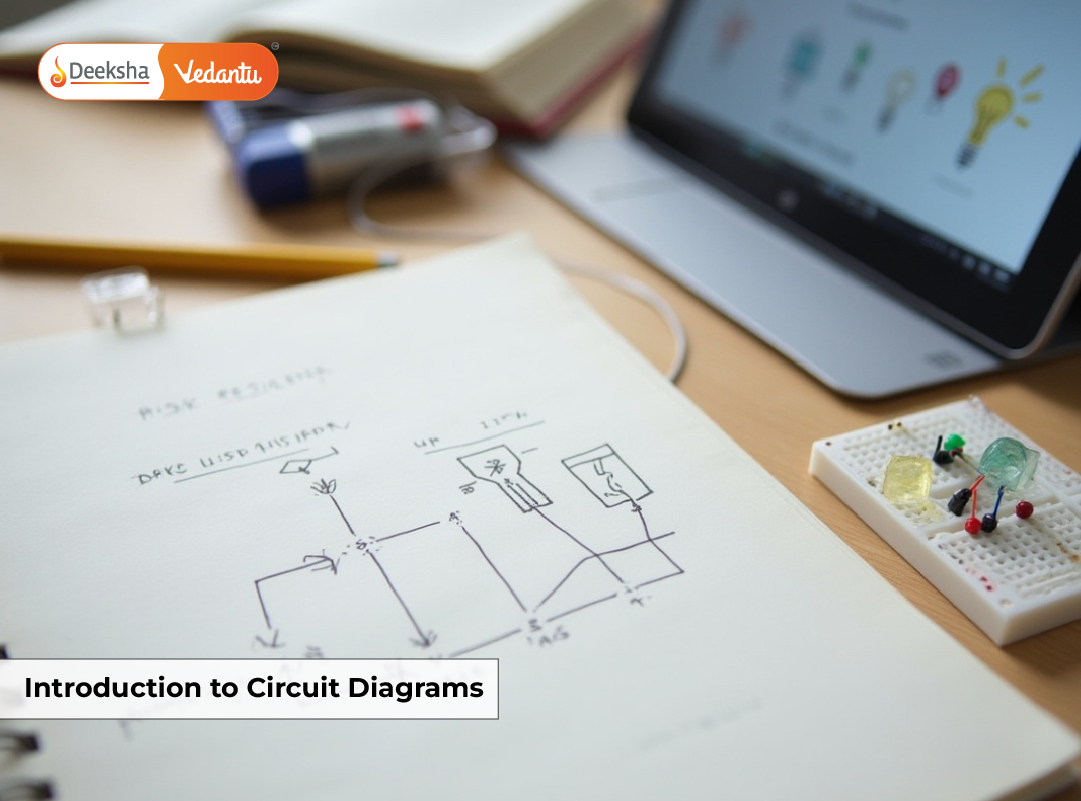What Are Circuit Diagrams?
Circuit diagrams, or electrical schematics, are simplified representations of electrical circuits using universally accepted symbols to denote various components. These diagrams allow students, technicians, and engineers to visualize the structure and function of electrical circuits.
Typically, a circuit diagram features straight lines representing wires and symbols representing components like resistors, bulbs, switches, and meters. The goal is to illustrate how electricity flows and how each component plays a role in the system.
At its core, a circuit diagram is both a learning and troubleshooting tool. It’s indispensable in physics classrooms and critical in real-life electrical work. At Deeksha Vedantu, we emphasize mastering this skill early, especially when covering electric current and circuits and the heating effect of electric current.
Importance of Learning Circuit Diagrams
Understanding how to interpret and draw circuit diagrams equips students with essential knowledge and practical skills:
- Simplifies Complex Systems: Abstract electrical processes become more understandable when visually represented.
- Essential for Physics and Engineering: Whether you’re studying electric potential or building circuits, these diagrams form the backbone of conceptual and applied learning.
- Enhances Safety Awareness: Knowing what each symbol represents helps avoid hazards in experiments and real-world installations.
- Aids in Design and Troubleshooting: Clear diagrams are used to construct and repair appliances, gadgets, and entire electrical systems.
- Supports Conceptual Learning: Recognizing patterns in diagrams helps reinforce the behavior of electric current and voltage.
For aspiring physicists, engineers, and electricians, mastering circuit diagrams is a foundational skill.
Common Circuit Diagram Symbols
A standardized set of symbols makes circuit diagrams universally understandable. Here are some key ones:
| Component | Symbol (Textual) | Description |
| Wire | ——— | Provides path for current |
| Resistor | Zigzag line | Restricts flow of current |
| Cell | Short + long vertical lines | Supplies electric energy |
| Battery | Group of cells | Increases total voltage supplied |
| Switch (Open) | Gap in line | Interrupts the circuit |
| Switch (Closed) | Line joined | Completes the circuit |
| Bulb (Lamp) | Circle with a cross | Glows when current flows through it |
| Ammeter | Circle with ‘A’ | Measures current |
| Voltmeter | Circle with ‘V’ | Measures voltage across components |
| Fuse | Rectangle with a line | Prevents excessive current by breaking |
| Ground/Earth | Three descending lines | Indicates connection to ground |
Familiarizing yourself with these symbols is crucial. Explore a full list on Circuit Diagram.
How to Draw Circuit Diagrams
Drawing an accurate and clean circuit diagram takes a step-by-step approach:
Step 1: Identify the Purpose of the Circuit
Understand what the circuit is intended to do—light a bulb, run a fan, or charge a battery.
Step 2: List the Components Required
Prepare a list of all necessary elements—batteries, resistors, bulbs, switches, meters, etc.
Step 3: Understand and Use Symbols
Use standard electrical symbols for each component to ensure the diagram is universally understandable.
Step 4: Connect Components Logically
Draw straight lines to represent wires and connect the components according to the circuit’s design.
Step 5: Indicate the Current Flow
Mark the direction of current (typically from positive to negative) using arrows.
Step 6: Label Everything Clearly
Label all components—R for resistor, S for switch, A for ammeter—along with voltage and current ratings if applicable.
Step 7: Keep It Neat and Scalable
Maintain clarity by spacing out symbols and keeping the diagram proportional. Avoid overlapping lines.
Electrical Circuit Diagrams in Real Life
Circuit diagrams go beyond theory. They are applied in various real-world contexts:
- Domestic Electric Circuits: They help understand how electricity is distributed from the main supply to appliances and switches in homes.
- Electronic Devices: From smartphones to televisions, internal wiring is mapped using schematics.
- Automobile Systems: Modern vehicles rely on complex circuit diagrams to manage lights, ignition, and entertainment systems.
- Industrial Machines: Engineers use diagrams to design, troubleshoot, and repair equipment.
- Renewable Energy Installations: Solar panel and inverter connections are designed and understood using circuit layouts.
Types of Circuits
Understanding different types of circuits helps predict their behavior and real-world applications.
Series Circuit
In a series circuit:
- All components are connected end-to-end.
- The same current flows through all components.
- The total resistance is the sum of individual resistances.
- If one component fails, the circuit is broken.
Example: Christmas lights connected in a single string.
Parallel Circuit
In a parallel circuit:
- Components are connected across common terminals.
- Voltage remains constant across branches.
- Current divides according to resistance.
- One component failing does not affect others.
Example: Home electrical wiring.
Mixed or Combination Circuit
- Features both series and parallel arrangements.
- Found in complex setups like washing machines or TVs.
Learning Resource: Understand how voltage varies in different circuits by visiting Electric Potential and Potential Difference.
Simple Circuit Examples for Students
Example 1: Basic Light Bulb Circuit
- 1 cell, 1 bulb, 1 switch.
- Shows how opening and closing the switch controls current.
Example 2: Series Circuit with Two Bulbs
- Demonstrates that removing one bulb turns both off.
- Useful for understanding series resistance.
Example 3: Parallel Circuit with Two Bulbs
- Each bulb has a separate path.
- If one bulb is removed, the other remains on.
Example 4: Circuit with Ammeter and Voltmeter
- Shows how current and voltage are measured.
- Helps students visualize electric current behavior.
Circuit Diagram Safety Tips
Even a basic circuit can be dangerous without proper precautions. Here’s how to stay safe:
- Power Off: Disconnect power before assembling or modifying circuits.
- Avoid Water: Never work with electricity near water or with wet hands.
- Use Appropriate Ratings: Match components with correct voltage and current specifications.
- Understand Circuit Behavior: Know the heating effect of current to prevent fires or damage.
- Use Proper Tools: Use insulated tools and avoid makeshift connections.
- Draw Before You Build: Sketching the diagram ensures safer and correct connections.
FAQs
1. What is a circuit diagram?
A circuit diagram is a symbolic drawing representing an electric circuit. It simplifies understanding and construction.
2. What is the difference between open and closed circuits?
An open circuit has a break and no current flows. A closed circuit is complete and allows current flow.
3. Why use standard symbols?
They make diagrams universally understandable and reduce errors during interpretation.
4. How do I practice drawing?
Start with simple setups, like a battery and bulb. Increase complexity by adding switches, meters, and resistors.
5. Who uses circuit diagrams?
Students, engineers, electricians, and technicians across fields like electronics, power generation, and automation.
Conclusion
Circuit diagrams form the foundation of understanding electrical systems. For students, mastering this topic means being better prepared for exams, labs, and real-life applications.
By learning the meanings of various circuit symbols, understanding how current flows, and differentiating between series and parallel circuits, you not only gain academic knowledge but also practical insight into everyday devices and systems.
From school labs to household wiring and high-end electronics, circuit diagrams are everywhere.
Final Thoughts:
- Start with the basics, like bulbs and batteries.
- Gradually introduce meters and multiple loops.
- Use online tools and textbooks to check your diagrams.
- Try redrawing real-life circuits from your surroundings.
Stay curious and safe while exploring the electrifying world of circuit diagrams!
Table of Contents










Get Social